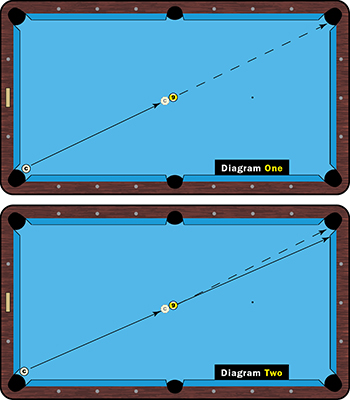Never miss those long straight shots again.
Hereís a a shot that comes up time and time again, and it immediately strikes fear into the shooterís heart. The shot, of course, is the long, straight diagonal shot, and Iíll bet most pros miss it 50 percent of the time under pressure and amateurs miss it at least 75 percent of the time under any circumstances.
Itís time to let the cat out of the bag and change those percentages.
Iím sure most of the pros that are consistently successful with this shot have an aiming system. You need to have a system because when the cue ball is deep in the pocket, getting your hand position right is difficult to do. You wind up with not much cue in your bridge hand and that makes it hard to put much of a stroke on the shot. The awkward bridging may also force you to elevate the back end of your cue. Additionally, looking back and forth at the cue ball and object ball adds difficulty.
So much can go wrong.
Hereís my system for making this shot. Iím sure other pros use the same system, but nobody speaks about it because they donít want other players to know the secret.

Hereís how I play the shot:
I find my alignment when I get down, looking from the cue ball to the object ball with my head above the cue (Diagram One). Then I get low and look through the contact point to the exact point in the pocket I want the object ball to hit. I pick a spot on the pocket and mentally ďmarkĒ it. Now, I really focus on aiming the cue ball at that point in the pocket. When I finally get down to shot, I double check the path from cue ball to object ball and where Iím aiming the cue ball in the pocket. I focus 100 percent on hitting the cue ball to my mark in the pocket. At this point, Iím not even looking at the object ball. I keep my eye on the cue ball on the back stroke. Of course, you have to finish with good execution, but youíll be amazed with the results. That confidence will also prevent you from jumping up on the shot or being anxious. If you can free up your mind and your stroke, youíre well on your way.
I also get asked what I do if the cue ball is left or right of the pocket. Diagram Two shows this setup. My objective is the same. I find a line from the cue ball to the object ball to a contact point in the pocket. Again, I pick out a spot in the pocket, but this time a touch more to the right of the object pocket from my cue ball pocket. That becomes my reference point. Itís something Iíve used my entire career and it has served me well. As I got more and more comfortable with this shot, I started to fire it in with speed. This becomes a huge benefit to your game.
So, on these long straight shots, or even just normal straight shots, use a target in the pocket for your cue ball. A lot of players do this. Taking the pressure off your aiming allows you a freer stroke.
Does this work for normal angled shots? No, because picking a spot on the rail is much harder. Itís easier to use a contact point on the object ball (ghost ball).





